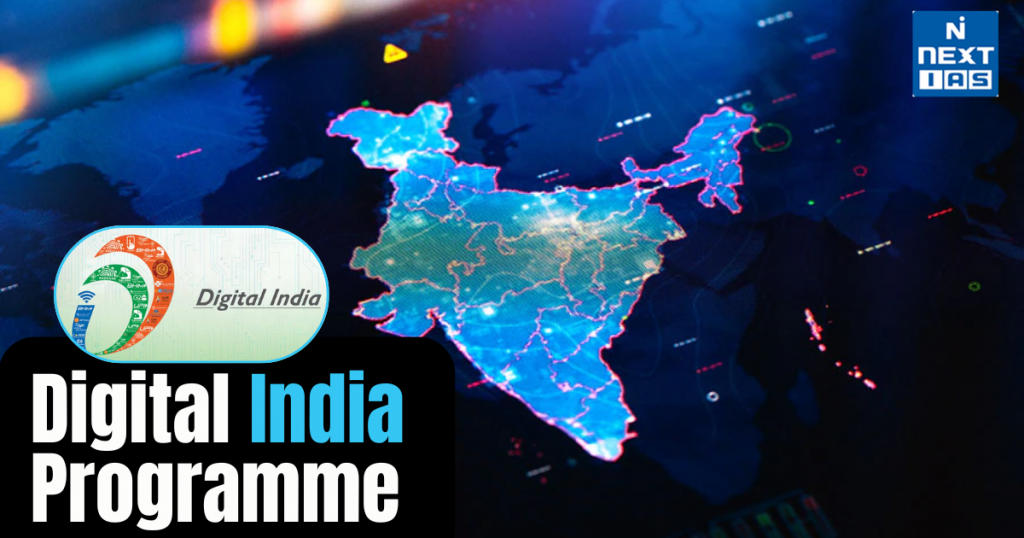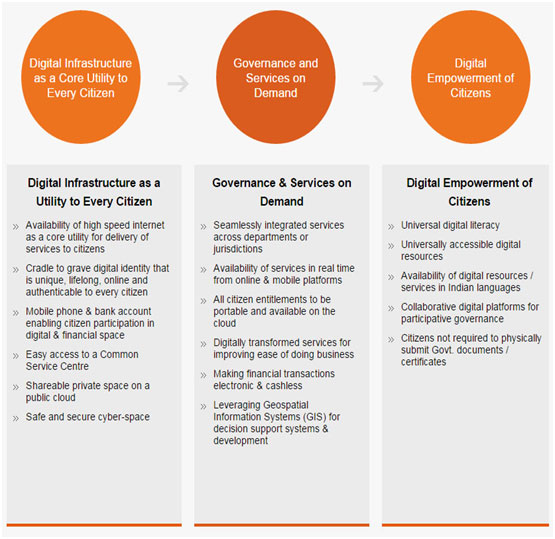
Digital India is a flagship programme of the Government of India, launched on July 1, 2015, by Honourable Prime Minister Shri Narendra Modi with the vision to transform India into a digitally empowered society and knowledge economy. Digital India has been improving the lives of all citizens through the digital delivery of services, expanding the digital economy and employment opportunities.
About the Digital India Programme
- The goal of the Digital India initiative is to make India a knowledge economy and digitally empowered society.
- Digital India is a transformative initiative that will guarantee citizens have electronic access to government services.
- A unique ID, e-Pramaan based on genuine, standard-based, interoperable, and interconnected government applications and data bases, and the need that government services be delivered online will all contribute to increased public accountability.
- In order to facilitate the digital delivery of services to residents, the Digital India program was introduced on July 1st, 2015.
- The expansion of the Digital India program was approved by the Union Cabinet in August 2023, based on the program’s success. It will cost ₹14,903 crores in total.

Features of the Digital India Programme
- Broadband Highways: Development of high-speed internet networks in rural and urban areas to ensure seamless connectivity.
- Universal Mobile Connectivity: Providing mobile network access to remote and underserved areas.
- Public Internet Access Programme: Expansion of Common Service Centers (CSCs) and Post Offices to serve as multi-service digital hubs.
- e-Governance and e-Kranti: Digital delivery of government services, such as Aadhaar-based authentication, e-Hospital, and e-Education.
- Digital Identity (Aadhaar): A unique biometric-based digital identity for citizens to access government services efficiently.
- Digital Payments: Promotion of cashless transactions through Unified Payments Interface (UPI), Bharat Interface for Money (BHIM), and other fintech solutions.
- Smart Cities and IoT: Integration of digital technology in urban planning, traffic management, and public utilities.
- Make in India and Electronics Manufacturing: Boosting domestic electronics manufacturing to reduce import dependency.
- IT for Jobs: Skill development programs to create employment opportunities in the IT sector.
- Cyber Security and Digital Literacy: Initiatives like the Cyber Swachhta Kendra and Pradhan Mantri Gramin Digital Saksharta Abhiyan (PMGDISHA) to ensure cyber safety and literacy.
Objectives of the Digital India Programme
- Digital Infrastructure as a Core Utility
- Provide high-speed internet access to all citizens, especially in rural areas.
- Establish a secure and stable digital identity for every citizen (Aadhaar).
- Ensure mobile connectivity and broadband access in all villages.
- Governance and Services on Demand
- Promote e-Governance by making all government services available digitally.
- Enable seamless digital transactions through initiatives like UMANG, DigiLocker, and e-Hospitals.
- Improve efficiency and transparency in government processes through automation and online access.
- Digital Empowerment of Citizens
- Enhance digital literacy, especially in rural areas, through programmes like PMGDISHA.
- Enable access to digital resources in regional languages.
- Ensure cybersecurity and data protection to build trust in digital platforms.
Additional Focus Areas
- Digital Payments: Promote cashless transactions through UPI, BHIM, and RuPay.
- Smart Cities and Innovation: Encourage technology-driven urban development.
- Startups and IT Growth: Support startups, digital entrepreneurship, and job creation.
Nine Pillars of Digital India
Digital India aims to provide the much needed thrust to the nine pillars of growth areas, namely
- Broadband Highways
- Universal Access to Mobile Connectivity
- Public Internet Access Programme
- e-Governance: Reforming Government through Technology
- e-Kranti – Electronic Delivery of Services
- Information for All
- Electronics Manufacturing
- IT for Jobs
- Early Harvest Programmes
Significance of the Digital India Programme
- Launched in 2015 by the Government of India, the Digital India Programme aims to transform India into a digitally empowered society and knowledge economy. This initiative is crucial in bridging the digital divide and ensuring that technology benefits all citizens.
- One of its primary significances is enhancing digital infrastructure. By expanding broadband connectivity, setting up Common Service Centers (CSCs), and promoting digital literacy, the program ensures that even rural areas have access to the internet and digital services.
- Another major impact is on governance and transparency. Through e-Governance initiatives like DigiLocker, e-Hospital, and MyGov, Digital India enhances public service delivery, reduces corruption, and makes government services more efficient and accessible.
- The program also boosts economic growth by promoting digital payments, e-commerce, and startups. Initiatives like UPI, Aadhaar-enabled Payment Systems (AePS), and BharatNet have revolutionized financial transactions, making India a global leader in digital payments.
- Furthermore, Digital India fosters innovation and job creation. The rise of IT-based startups, digital marketing, and cybersecurity sectors has opened up numerous employment opportunities.
- In education and healthcare, Digital India plays a transformative role by enabling online learning platforms, telemedicine, and digital prescriptions, making essential services more inclusive.
- Overall, the Digital India Programme is a game-changer in making technology a tool for development, inclusion, and empowerment, paving the way for a self-reliant and digitally forward India.
Lacunae of the Digital India Programme
- The Digital India Programme, launched in 2015, aims to transform India into a digitally empowered society and knowledge economy. While it has made significant progress, several challenges persist.
- One major issue is the digital divide. Despite increased internet penetration, rural areas still face connectivity issues due to inadequate infrastructure and high costs. Limited digital literacy further exacerbates this divide, restricting access to government services.
- Another concern is cybersecurity and data privacy. The rapid digitization of services has led to a rise in cyber threats, data breaches, and identity thefts. The absence of a robust data protection law raises concerns about the misuse of citizens’ personal data.
- The slow implementation of e-governance services is another bottleneck. Many government websites and applications suffer from poor design, inefficiency, and frequent downtimes, affecting service delivery. Additionally, bureaucratic resistance and lack of coordination between central and state governments hinder seamless execution.
- The job displacement caused by automation and digitization also poses a challenge. Many low-skilled workers struggle to adapt to the digital economy, leading to employment uncertainties.
- Lastly, affordability issues affect many citizens. While smartphones and data costs have decreased, they still remain expensive for economically weaker sections, limiting digital inclusion.
- To make Digital India more effective, the government must bridge infrastructure gaps, enhance cybersecurity, promote digital literacy, and ensure affordable access to technology. A more inclusive approach will help India achieve true digital empowerment.
Key Pointers of the Digital India Programme for UPSC CSE Prelims
Overview
- Launched: 1st July 2015
- Nodal Ministry: Ministry of Electronics & Information Technology (MeitY)
- Vision: Transform India into a digitally empowered society and knowledge economy.
Pillars of Digital India
- Broadband Highways – Nationwide high-speed internet connectivity.
- Universal Access to Mobile Connectivity – Improve network access in remote areas.
- Public Internet Access Programme – Common Service Centres (CSCs) & Post Offices as multi-service hubs.
- e-Governance: Reforming Government through Technology – Paperless governance, online services.
- e-Kranti: Electronic Delivery of Services – Digital delivery of government schemes.
- Information for All – Open data platforms, proactive governance.
- Electronics Manufacturing – Boost domestic production, reduce imports.
- IT for Jobs – Digital skill training and employment in IT sector.
- Early Harvest Programmes – Immediate impact initiatives (biometric attendance, Wi-Fi in universities, etc.).
Key Initiatives under Digital India
- Aadhaar – Biometric-based unique ID.
- BharatNet – Broadband to gram panchayats.
- UMANG App – Single-window for e-governance services.
- DigiLocker – Digital document storage.
- e-Hospital – Online health services.
- eNAM – National Agricultural Market.
- PM WANI – Public Wi-Fi access network.
- National Digital Health Mission (NDHM) – Digital health records.
Way Forward
The Digital India Programme’s way forward involves expanding digital infrastructure, enhancing cybersecurity, promoting AI and blockchain adoption, and ensuring digital literacy for all. Strengthening e-governance, boosting rural connectivity, and fostering innovation-driven startups will accelerate India’s digital transformation, making services more accessible, efficient, and inclusive for economic and social growth.
Conclusion
The Digital India Programme has revolutionized governance, connectivity, and digital empowerment in India. It has enhanced e-governance, financial inclusion, and digital literacy while boosting economic growth. Challenges like cybersecurity and digital divide remain, but its impact on innovation, transparency, and accessibility has transformed India into a digitally empowered society and knowledge economy.
Sources:





